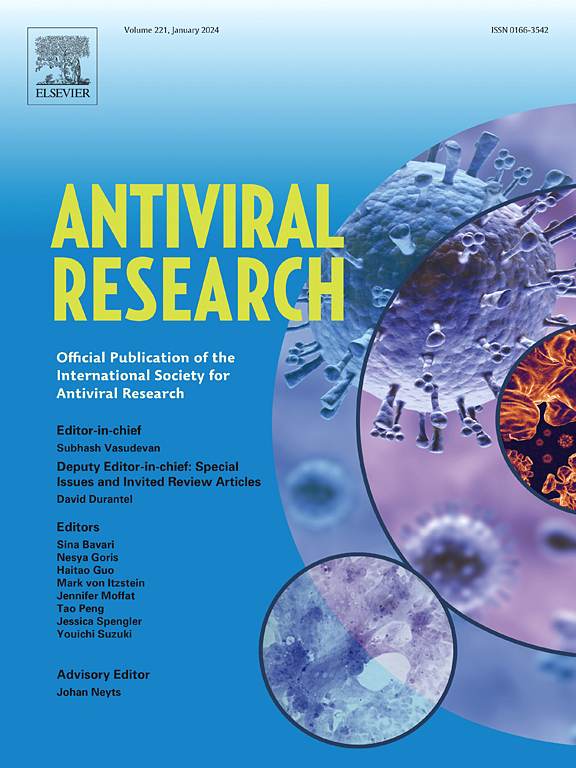Pretreatment viral quasispecies characteristics and evolutionary phases correlate with HBsAg seroconversion in peginterferon-alfa-2a-treated children with HBeAg-positive chronic hepatitis B
IF 4
2区 医学
Q1 PHARMACOLOGY & PHARMACY
引用次数: 0
Abstract
Background & aims
To evaluate baseline HBV quasispecies (QS) characteristics as a predictor of HBsAg seroconversion in peginterferon-alfa-2a-treated HBeAg-positive pediatric chronic hepatitis B (CHB).
Methods
25 patients achieved HBsAg seroconversion (SS group) and another 25 did not (SN group) were enrolled, matched for baseline profiles. Full-length HBV genomes were obtained from pretreatment serum via clone sequencing. Twelve untreated carriers (CA group) served as controls.
Results
SN group demonstrated significantly higher genetic distance (GD) and mutation frequency index (MFI) in the preCore/Core (preC/C) gene versus SS and CA groups (p < 0.05). Treatment failure exclusively correlated with G1896A/C1913A/C2078G mutations. Jonckheere-Terpstra test confirmed a CA→SS→SN diversity gradient in preC/C (p < 0.05). Non-invasive fibrosis indices increased across CA→SS→SN (p < 0.05) and correlated positively with QS diversity. Evolutionary analyses revealed divergent haplotype clustering in SN versus star-like radiation patterns in CA/SS. Phylogenetic analysis positioned CA/SS haplotypes at earlier evolutionary phases, while SN haplotypes at a later phase. Notably, haplotypes harboring the three aforementioned mutations were also located at the later phase. Positive selection analysis identified two SN-specific mutations (codon 34[C1913A] and 89[C2078G]). A LASSO-derived predictive model (age, C1913A/C2078G, preC/C MFI) yielded the area under the receiver operating characteristic curve (AUROC) 0.814 (sensitivity 92 %, specificity 68 %).
Conclusions
Lower baseline HBV quasispecies diversity predicts Peginterferon-alfa-2a-induced HBsAg seroconversion in pediatric CHB. The observed diversity continuum, association with fibrosis indices, suggests seroconversion occurs preferentially during earlier hepatitis phases. Pretreatment viral genetic profiling may optimize therapeutic timing, highlighting its prognostic value for childhood HBV management.
聚乙二醇干扰素- α -2a治疗的hbeag阳性慢性乙型肝炎患儿中预处理病毒准种特征和进化阶段与HBsAg血清转化相关
背景与目的:评估基线HBV准种(QS)特征作为聚乙二醇干扰素- α -2a治疗的hbeag阳性儿童慢性乙型肝炎(CHB) HBsAg血清转化的预测因子。方法:25例患者实现HBsAg血清转化(SS组),另外25例患者未实现HBsAg血清转化(SN组),基线资料匹配。通过克隆测序从预处理血清中获得HBV全长基因组。12例未经治疗的携带者(CA组)作为对照组。结果:与SS和CA组相比,SN组的preore /Core (preC/C)基因遗传距离(GD)和突变频率指数(MFI)显著高于SS和CA组(结论:较低的基线HBV准种多样性预测聚干扰素- α -2a诱导的儿童CHB HBsAg血清转化。观察到的多样性连续体与纤维化指数相关,表明血清转化优先发生在早期肝炎阶段。预处理病毒遗传谱分析可以优化治疗时机,突出其对儿童HBV管理的预后价值。
本文章由计算机程序翻译,如有差异,请以英文原文为准。
求助全文
约1分钟内获得全文
求助全文
来源期刊

Antiviral research
医学-病毒学
CiteScore
17.10
自引率
3.90%
发文量
157
审稿时长
34 days
期刊介绍:
Antiviral Research is a journal that focuses on various aspects of controlling viral infections in both humans and animals. It is a platform for publishing research reports, short communications, review articles, and commentaries. The journal covers a wide range of topics including antiviral drugs, antibodies, and host-response modifiers. These topics encompass their synthesis, in vitro and in vivo testing, as well as mechanisms of action. Additionally, the journal also publishes studies on the development of new or improved vaccines against viral infections in humans. It delves into assessing the safety of drugs and vaccines, tracking the evolution of drug or vaccine-resistant viruses, and developing effective countermeasures. Another area of interest includes the identification and validation of new drug targets. The journal further explores laboratory animal models of viral diseases, investigates the pathogenesis of viral diseases, and examines the mechanisms by which viruses avoid host immune responses.
 求助内容:
求助内容: 应助结果提醒方式:
应助结果提醒方式:


